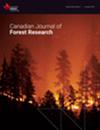Intensive management increases flexibility in managing wood supply
IF 1.5
3区 农林科学
Q2 FORESTRY
引用次数: 0
Abstract
We modelled the potential impact of intensification of plantation management and thinning, on timber supply of an ~500,000 ha forest in Alberta, Canada over a 200-year planning horizon. Pre-commercial and commercial thinning were applied to a portion of the better sites, which allowed shortening of the time to merchantability and earlier harvest than unthinned stands; less than 25% of the forest was thinned over the course of the plan. The sustainable harvest rate, represented here as the annual allowable cut (AAC), increased by ~14% above baseline, when thinning was applied. Similarly, there was a 20.7% increase in AAC projected with the relaxation of even flow rules if thinning was also applied. Finally, thinning offset the expected decline in AAC after a 20-year surge in cutting of mature pine, designed to slow an epidemic of mountain pine beetle. In terms of wood supply, the volume extracted at thinning was <2% of annual supply but volume from final harvest from thinned stands, at times, surpassed that of unthinned stands of the forest. Individual tree size from thinned stands was ~twice that from unthinned areas in the second part of the planning period, offsetting the expected decline in piece size after the era of harvest of natural forests.集约化管理增加了木材供应管理的灵活性
我们模拟了在200年的规划期内,加强种植园管理和疏伐对加拿大阿尔伯塔省约500000公顷森林木材供应的潜在影响。对一部分较好的林分进行了商业化前和商业化疏伐,这缩短了可销售性的时间,并比未疏伐的林分更早收获;在该计划的实施过程中,只有不到25%的森林被砍伐。当进行间伐时,可持续收获率(此处表示为年允许采伐量(AAC))比基线增加了约14%。同样,如果也应用减薄,随着均匀流动规则的放松,预计AAC将增加20.7%。最后,在20年来为减缓山地松甲虫的流行而大量砍伐成熟松树后,疏伐抵消了AAC的预期下降。就木材供应而言,疏伐时提取的木材量小于年供应量的2%,但疏伐林分最终收获的木材量有时超过了未疏伐林分。在规划期的第二部分,疏伐林分的单株大小大约是未疏伐地区的两倍,抵消了天然林采伐时代后预计的单株大小下降。
本文章由计算机程序翻译,如有差异,请以英文原文为准。
求助全文
约1分钟内获得全文
求助全文
来源期刊
CiteScore
4.20
自引率
9.10%
发文量
109
审稿时长
3 months
期刊介绍:
Published since 1971, the Canadian Journal of Forest Research is a monthly journal that features articles, reviews, notes and concept papers on a broad spectrum of forest sciences, including biometrics, conservation, disturbances, ecology, economics, entomology, genetics, hydrology, management, nutrient cycling, pathology, physiology, remote sensing, silviculture, social sciences, soils, stand dynamics, and wood science, all in relation to the understanding or management of ecosystem services. It also publishes special issues dedicated to a topic of current interest.

 求助内容:
求助内容: 应助结果提醒方式:
应助结果提醒方式:


